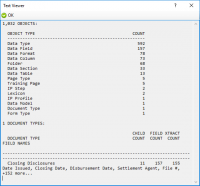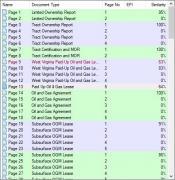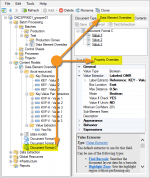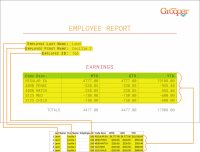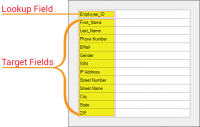|
|
| (5 intermediate revisions by 2 users not shown) |
| Line 1: |
Line 1: |
| Technically speaking, what is '''Grooper'''? '''Grooper''' is a '''[https://en.wikipedia.org/wiki/Information_repository repository]''' of information made up by 13 tables in a '''[https://en.wikipedia.org/wiki/Microsoft_SQL_Server SQL Server]''' '''[https://en.wikipedia.org/wiki/Database Database]''' and associated files in a '''[https://en.wikipedia.org/wiki/Microsoft_Windows Windows]''' file share. This information is displayed to the user via an '''[https://en.wikipedia.org/wiki/Application_software application(s)]''' that displays a 1 to 1 relationship of what exists in that database and fileshare. Gaining an understanding of how to properly create using '''Grooper''' begins by first understanding the structure of its architecture, and why it is built the way it is. This sets a foundational groundwork for knowing how to think and interact with the application.
| | {|cellpadding="15" cellspacing="10" width="100%" |
| | |-style="background-color:#f89420; color:white; font-size:16pt" |
| | |colspan="4"|'''Getting Started''' |
| | |-style="background-color:#fde6cb" valign="top" |
| | |rowspan="3" style="width:75%"| |
| | Grooper was built from the ground up by BIS, a company with 35 years of continuous experience developing and delivering new technology. Grooper is an intelligent document processing and digital data integration solution that empowers organizations to extract meaningful information from paper/electronic documents and other forms of unstructured data. |
|
| |
|
| ==Grooper infrastructure==
| | The platform combines patented and sophisticated image processing, capture technology, machine learning, natural language processing, and optical character recognition to enrich and embed human comprehension into data. By tackling tough challenges that other systems cannot resolve, Grooper has become the foundation for many industry-first solutions in healthcare, financial services, oil and gas, education, and government. |
| [[file:GrooperInfrastructure01.png]]
| |
|
| |
|
| ==System Architecture and Requirements== | | |[https://xchange.grooper.com/discussion/57/read-me-getting-started Getting Started] |
| ===End User PC=== | | |-style="background-color:#fde6cb" valign="top" |
| * The ''end user pc'' would include '''Grooper Thick Clients''' and installations on premisis.
| | |[[Install and Setup]] |
| * Network latency should be (ideally) less than 50ms.
| | |-style="background-color:#fde6cb" valign="top" |
| * Network throughput should be (ideally) greater than 50MB.
| | |[https://grooper.bisok.com/Documentation/2.90/Main/HTML5/index.htm#t=Start_Page.htm 2.90 Reference Documentation] |
| | |} |
| | {|cellpadding="15" cellspacing="10" |
| | |-style="background-color:#36b0a7; color:white; font-size:16pt" |
| | |style="width:50%"|'''Featured Articles'''||'''Did you know?''' |
| | |-style="background-color:#d8f3f1" valign="top" |
| | | |
| | <blockquote style="font-size:14pt"> |
| | ''[[Delimited Extract]]'' |
| | </blockquote> |
|
| |
|
| ===Grooper Processing Server===
| | ''Delimited Extract'' is one of the '''''Extract Method''''' options for '''Data Table''' objects in a '''Data Model'''. This method extracts tabular data from a delimiter-separated text file, such as a CSV file. |
| * A '''Grooper''' processing environment can have as many servers as is necssary to meet business requirements.
| |
| * [https://en.wikipedia.org/wiki/Windows_10 Windows 10] and/or [https://en.wikipedia.org/wiki/Windows_Server_2012 Windows Server 2012] or later is required.
| |
| * Server RAM should be 16GB or more.
| |
| * The CPU should consist of 4 or more cores.
| |
| * The port for licensing is 13900 by default.
| |
|
| |
|
| ===Grooper SQL Server===
| | This is the fastest, simplest and most effective method of extracting data from character delimited files, such as comma delimited CSV files or TXT files delimited by commas or other characters. |
| * [https://en.wikipedia.org/wiki/Microsoft_SQL_Server#SQL_Server_2012 SQL Server 2012] or later is required.
| |
| * The '''Grooper Database ''' should allow for a size of 20GB or more.
| |
| * The scaling of the '''Grooper Database''' should be set to percentage, ideally, not the default of a few MB. This will reduce frequent scaling that hinders performance.
| |
| * The SQL Port is 1433.
| |
|
| |
|
| ===Grooper FileStore Share=== | | {|cellpadding="10" cellspacing="5" |
| * This can be local to the '''Grooper SQL Server''' or managed on a separate server.
| | |-style="background-color:#36b0a7; color:white" |
| * The ieal filesize would accomodate for roughly 150GB for small to medium installs.
| | |style="font-size:14pt"|'''FYI''' |
| * The authentication requires CIFS or SMB.
| | | |
| | ''Delimited Extract'' is new to version '''2021'''. In older versions, this functionality was achieved with the ''CSV Extract'' table extraction method. ''Delimited Extract'' expands the ''CSV Extract'' functionality to extract tabular data from TXT files using delimiter characters besides a comma, such as semicolons or pipe characters. |
| | |} |
| | | |
| | The earliest examples of OCR (Optical Character Recognition) can be traced back to the 1870s. Early OCR devices were actually invented to aid the blind. This included "text-to-speech" devices that would scan black print and produce sounds a blind person could interpret, as well as "text-to-tactile" machines which would convert luminous sensations into tactile sensations. Machines such as these would allow a blind person to read printed text not yet converted to Braille. |
|
| |
|
| ===Windows Prerequisites===
| | The first business to install an OCR reader was the magazine ''Reader's Digest'' in 1954. The company used it to convert typewritten sales reports into machine readable punch cards. |
| The following are included in the installation package of '''Grooper''' and are required for installation (listed are x64 packages.) | |
|
| |
|
| * '''vc_redist_2012_update4_x64'''
| | It would not be until 1974 that OCR starts to form as we imagine it now with Ray Kurzweil's development of the first "omni-font" OCR software, capable of reading text of virtually any font. |
| *: Microsoft Visual C++ 2012 Redistributable (x64) - 11.0.61030
| | |} |
| * '''vc_redist_2010_sp1_x64'''
| |
| *: Microsoft Visual C++ 2010 x64 Redistributable Setup
| |
| * '''vc_redist_2013_x64'''
| |
| *: Microsoft Visual C++ 2013 Redistributable (x64) - 12.0.30501
| |
| * '''vc_redist.x64'''
| |
| *: Microsoft Visual C++ 2017 Redistributable (x64) - 14.10.25017
| |
| : Visual C++ Redistributable Packages install runtime components of Visual C++ Libraries on a computer that does not have Visual C++ installed. The libraries are required to run applications that are developed by using the corresponding version of Visual C++.
| |
| * '''NDP462-DevPack-KB3151934-ENU'''
| |
| *: Microsoft .NET Framework 4.6.2 Developer Pack
| |
| : .NET is an integral part of many apps running on Windows and provides common functionality for those apps to run. For developers, the .NET Framework provides a comprehensive and consistent programming model for building apps that have visually stunning user experiences and seamless and secure communication.
| |
| * '''SQLSysClrTypes'''
| |
| : In LINQ to SQL, the data model of a relational database maps to an object model that is expressed in the programming language of your choice. When the application runs, LINQ to SQL translates the language-integrated queries in the object model into SQL and sends them to the database for execution. When the database returns the results, LINQ to SQL translates the results back to objects that you can work with in your own programming language.
| |
| : In order to translate data between the object model and the database, a type mapping must be defined. LINQ to SQL uses a type mapping to match each common language runtime (CLR) type with a particular SQL Server type. You can define type mappings and other mapping information, such as database structure and table relationships, inside the object model with attribute-based mapping. Alternatively, you can specify the mapping information outside the object model with an external mapping file.
| |
| * '''AccessDatabaseEngine_x64'''
| |
| :Microsoft Access Database Engine contains essential components that make it possible for Microsoft Office programs to interact with software services and applications that do not belong to Microsoft. For instance, if you are working in a program that gives you the possibility to export tables directly to Microsoft Access, then you need the database engine to make that happen.
| |
| :The Microsoft Access Database Engine is available in multiple editions, which mainly depend on which Microsoft Office product you’re using. The hint is in the year. As such, if you use Microsoft Office 2016, then you need Microsoft Access Database Engine 2016.
| |
| | |
| * ReportViewer
| |
| : Used for viewing built in '''Grooper Reports''', which uses a Microsoft Reporting framework.
| |
| | |
| [[file:SystemArchitecture.png]]
| |
| | |
| ==The Four Layers of Grooper==
| |
| '''Grooper''' consists of four main components that constantly interact with one another:
| |
| # Database
| |
| # '''[[File Store]]'''
| |
| # Licensing
| |
| # Application
| |
|
| |
|
| ===The Database===
| |
| This is the core component of '''Grooper''' as all aspects of the functionality and configuration of a '''Grooper''' repository are stored here as '''[https://en.wikipedia.org/wiki/Metadata metadata]''' in '''[https://en.wikipedia.org/wiki/Table_(information) tables]'''. There are 13 tables that make up the '''Grooper''' database:
| |
|
| |
|
| '''dbo.AccessControlEntry''' | | {|cellpadding="15" cellspacing="10" |
| * This table contains the information necessary for implementing '''Grooper’s''' node-level security architecture.
| | |-style="background-color:#f89420; color:white; font-size:16pt" |
| :: {| class="wikitable"
| | |style="width:50%"|'''New in 2.9'''||'''Featured Use Case''' |
| ! Column Name !! Data Type !! Size !! Description | | |-style="background-color:#fde6cb" valign="top" |
| |- | | | |
| | Id || int || 10 || unique number referencing the table's row
| | {|cellpadding=5 cellspacing=2 style="margin:auto" |
| |-
| | !colspan="4" style="padding: 25px" | <blockquote style="font-size:14pt">Welcome to '''Grooper 2.9'''!<br/>Below you will find helpful links to all the articles about the new/changed functionality in this version of '''Grooper'''.</blockquote> |
| | NodeId || uniqueidentifier || 16 || guid associated with node from '''Grooper''' node tree
| |
| |-
| |
| | PrincipalId || uniqueidentifier || 16 ||
| |
| |- | | |- |
| | Permissions || in || 4 || | | |[[Image:Compile_stats_02.png|center|200px|link=Compile Stats]] |
| |} | | |[[Image:Microsoft_office_integration_000.png|center|200px|link=Microsoft Office Integration]] |
| '''dbo.CustomStats'''
| | |[[Image:document_viewer_00.png|center|150px|link=Document Viewer]] |
| * ''Definition incoming ...''
| | |[[Image:Separation_and_review_18.png|center|175px|link=Separation and Separation Review]] |
| :: {| class="wikitable"
| |
| ! Column Name !! Data Type !! Size !! Description
| |
| |- | | |- |
| | SessionId || int || 4 || | | |style="text-align:center"|'''[[Compile Stats]]''' |
| | |style="text-align:center"|'''[[Microsoft Office Integration]]''' |
| | |style="text-align:center"|'''[[Document Viewer]]''' |
| | |style="text-align:center"|'''[[Separation and Separation Review]]''' |
| |- | | |- |
| | Name || Varchar || 64 || | | |[[Image:data_review_00.png|center|200px|link=Data Review]] |
| | |[[Image:Weighted_rules_00.png|center|200px|link=Confidence Multiplier]] |
| | |[[Image:Data_element_overrides_000.png|center|150px|link=Data Element Overrides]] |
| | |[[Image:Database_export_002.png|center|200px|link=Database Export]] |
| |- | | |- |
| | Value || Float || 8 || | | |style="text-align:center"|'''[[Data Review]]''' |
| |} | | |style="text-align:center"|'''[[Confidence Multiplier]]''' |
| '''dbo.FileStoreEntry''' | | |style="text-align:center"|'''[[Data Element Overrides]]''' |
| * This table contains the information necessary for associating filestore objects with '''Grooper''' nodes. Note: a node with associated files will also contain those files’ filestore object locations, names, and mimetypes in the “files” column of TreeNode.
| | |style="text-align:center"|'''[[Database Export]]''' |
| :: {| class="wikitable"
| |
| ! Column Name !! Data Type !! Size !! Description
| |
| |- | | |- |
| | Id || int || 4 || sequential number assigned to object in row | | |[[Image:Cmis_lookup_002.png|center|200px|link=CMIS Lookup]] |
| | |[[Image:Content_type_filter_000.png|center|100px|link=Content Type Filter]] |
| | |[[Image:Output_extractor_key_000.png|center|200px|link=Output Extractor Key]] |
| | |[[Image:box_cmis_binding_000.png|center|200px|link=Box (CMIS Binding)]] |
| |- | | |- |
| | FileId || uniqueidentifier || 16 || guid assigned as the name of the object (stored in the filestore with this number followed by .grp) | | |style="text-align:center"|'''[[CMIS Lookup]]''' |
| | |style="text-align:center"|'''[[Content Type Filter]]''' |
| | |style="text-align:center"|'''[[Output Extractor Key]]''' |
| | |style="text-align:center"|'''[[Box (CMIS Binding)]]''' |
| |- | | |- |
| | NodeId || uniqueidentifier || 16 || guid associated with node from '''Grooper''' tree | | |colspan="4"|[[Image:Linq_to_grooper_objects_001.png|center|200px|link=LINQ to Grooper Objects]] |
| |- | | |- |
| | FileStoreId || uniqueidentifier || 16 || guid given to the node referencing the file store | | |colspan="4" style="text-align:center"|'''[[LINQ to Grooper Objects]]''' |
| |} | | |} |
| '''dbo.License'''
| | |
| * This table contains information relating to '''Grooper''' licensing, including the licensing and tamper keys.
| | | |
| :: {| class="wikitable" | | [[File:American-airlines-credit-union-financial-services-document-data-capture-integration-grooper.jpg|400px|right|link=https://www.bisok.com/case-studies/electronic-data-discovery-case-study/]] |
| ! Column Name !! Data Type !! Size !! Description
| | |
| |-
| | <blockquote style="font-size:14pt"> |
| | Id || int || 4 || unique number referencing the table’s row | | '''They’re Saving Over 5,000 Hours Every Year in Data Discovery and Processing''' |
| |-
| | </blockquote> |
| | SerialNumber || uniqueidentifier || 16 || guid of serial number
| | |
| |-
| | |
| | LicenseText || Varchar || 1024 ||
| | American Airlines Credit Union has transformed their data workflows, quickly saving thousands of hours in electronic data discovery , resulting in much greater efficiency and improved member services. |
| |-
| | |
| | CustomerId || Varchar || 256 || number given to customer owning the license
| | Discover how they: |
| |-
| | |
| | CustomerName || varchar || 256 || string name given to customer owning the license
| | * Quickly found 40,000 specific files among one billion |
| |-
| | * Easily integrated with data silos and content management systems when no other solution would |
| | MachineId || varchar || 40 || unique identifier of the machine which the license was generated for
| | * Have cut their mortgage processing time in half (and they process mortgages for 47 branch offices!) |
| |-
| | * Learn from the document and electronic data discovery experts at BIS! |
| | LicenseCode || varchar || 50 || shorthand for the type of license assigned
| | |
| |-
| | [https://www.bisok.com/case-studies/electronic-data-discovery-case-study/ You can access the full case study clicking this link]. |
| | LicenseDesc || varchar || 256 || description of the type of license assigned
| |
| |-
| |
| | Quantity || int || 4 || amount of licenses given upon assignment
| |
| |-
| |
| | Expires || int ||4 ||
| |
| |-
| |
| | ExpirationDate || datetime || 8 || date and time the assigned license expires
| |
| |-
| |
| | ResetInterval || varchar || 12 || basis on which the assigned licenses resets
| |
| |-
| |
| | LastReset || datetime || 8 || date and time the license was last reset
| |
| |-
| |
| | RemainingCount || int || 4 || amount of licenses remaining since assigned
| |
| |-
| |
| | TamperKey || varchar || 256 ||
| |
| |} | | |} |
| '''dbo.LicenseCheckout'''
| | ==== <span style="color:white">Feedback</span> ==== |
| * This table contains information relating to checked out licenses.
| | |
| :: {| class="wikitable"
| | {|cellpadding="15" cellspacing="10" width="100%" |
| ! Column Name !! Data Type !! Size !! Description
| | |-style="background-color:#36b0a7; color:white; font-size:16pt" |
| |- | | |colspan=2|'''Feedback''' |
| | Id || int || 4 || unique number referencing the table’s row
| | |-style="background-color:#d8f3f1" valign="center" |
| |-
| | |style="width:25%"| |
| | LicenseCode || varchar || 50 || string defining the license code
| | [[File:Gartner pi.jpg|link=https://www.gartner.com/reviews/market/data-and-analytics-others/vendor/bis/product/grooper]] |
| |-
| | | |
| | LicenseDesc || varchar || 256 || definition of the type of license in use
| | <span style="font-size:14pt">We value your feedback!<br><br>Help us improve our product by leaving us a review on [https://www.gartner.com/reviews/market/data-and-analytics-others/vendor/bis/product/grooper Gartner.com].<br><br>Click the image to the left to submit a review.</span> |
| |-
| |
| | UserName || varchar || 256 || windows user to whom the license is checked to
| |
| |-
| |
| | MachineName || varchar || 256 || hostname of machine using the license
| |
| |-
| |
| | ModuleName || varchar || 256 || '''Grooper''' module occupying the license
| |
| |-
| |
| | CheckoutTime || datetime || 8 || date and time the license was checked out
| |
| |-
| |
| | CheckoutId || uniqueidentifier || 16 ||
| |
| |}
| |
| '''dbo.Lock'''
| |
| * This table contains one row per locked node; prevents overlapping access to various resources.
| |
| :: {| class="wikitable" | |
| ! Column Name !! Data Type !! Size !! Description
| |
| |- | |
| | NodeId || uniqueidentifier || 16 || guid of node from '''Grooper''' hierarchy tree
| |
| |- | |
| | UserName || varchar || 64 || windows user that applied the unlock
| |
| |-
| |
| | MachineName || varchar || 64 || hostname of the machine where the unlock occurred
| |
| |-
| |
| | ModuleName || varchar || 64 || '''Grooper''' module that executed the unlock
| |
| |-
| |
| | ProcedureName || varchar || 64 || the procedure executed to apply the unlock
| |
| |-
| |
| | CreateDate || smalldatetime || 4 || date and time the unlock occurred
| |
| |}
| |
| '''dbo.Log'''
| |
| * This table contains the '''Grooper''' log, which is represented in the '''Event Viewer''' of '''Grooper Design Studio'''.
| |
| :: {| class="wikitable" | |
| ! Column Name !! Data Type !! Size !! Description
| |
| |-
| |
| | Id || int || 4 || unique row identifier
| |
| |-
| |
| | TimeStamp || datetime || 8 || date and time the event was logged
| |
| |-
| |
| | Type || int || 4 || type of event logged
| |
| |-
| |
| | ProcName || varchar(MAX) || -1 || name of procedure associated with the event
| |
| |-
| |
| | Message || varchar(MAX) || -1 || message displayed in and defining, in general, the event
| |
| |-
| |
| | UserAccount || varchar || 64 || windows user under which the event triggered
| |
| |-
| |
| | MachineName || varchar || 64 || hostname of the machine under which the event triggered
| |
| |-
| |
| | NodeId || uniqueidentifier || 16 || guid of parent node associated with ‘NodeName’
| |
| |-
| |
| | NodeName || varchar || 256 || Item Name, or name of node associated with the triggering of the event
| |
| |-
| |
| | NodeType || varchar || 64 || type of '''Grooper''' Node defining the ‘NodeName’
| |
| |} | |
| '''dbo.NodeReference'''
| |
| * This table contains a list of all referenced nodes, and what other nodes they are referenced by. Used to protect referenced nodes from deletion, and in determining what nodes are necessary on exporting.
| |
| :: {| class="wikitable"
| |
| ! Column Name !! Data Type !! Size !! Description
| |
| |- | |
| | NodeId || uniqueidentifier || 16 || guid given to node in '''Grooper''' hierarchy tree
| |
| |-
| |
| | ReferencingNodeId || uniqueidentifier || 16 || guid of parent node associated with ‘NodeId’
| |
| |}
| |
| '''dbo.ProcessingTask'''
| |
| * This table contains tasks submitted for activity processing as part of production batches.
| |
| :: {| class="wikitable"
| |
| ! Column Name !! Data Type !! Size !! Description
| |
| |-
| |
| | Id || int || 4 || unique row identifier
| |
| |-
| |
| | BatchId || uniqueidentifier || 16 || guid of batch related to running process
| |
| |-
| |
| | NodeId || uniqueidentifier || 16 || guid of node related to batch in running process
| |
| |-
| |
| | Settings || varchar(MAX) || -1 || json properties of running node
| |
| |-
| |
| | ModuleName || varchar || 256 || module running current task
| |
| |-
| |
| | Status || int || 4 || status of current task (i.e. running, error…)
| |
| |-
| |
| | UserName || varchar || 256 || windows user that submitted task
| |
| |-
| |
| | MachineName || varchar || 256 || hostname of machine running task
| |
| |-
| |
| | PageCount || int || 4 || number of pages in batch being processed
| |
| |-
| |
| | Submitted || datetime || 8 || date/time when processing batch was submitted
| |
| |-
| |
| | Started || datetime || 8 || date/time when processing batch started
| |
| |-
| |
| | Completed || datetime || 8 || date/time when batch process completed
| |
| |-
| |
| | Priority || int || 4 || numeric value (1-5) given to sort batch priority | |
| |-
| |
| | Scope || int || 4 || the level of the batch that a step is processing
| |
| |-
| |
| | StepNo || int || 4 || current step of batch process
| |
| |-
| |
| | BatchName || varchar || 256 || name of batch in processing
| |
| |-
| |
| | BatchProcessName || varchar || 256 || name of process associated with batch in processing
| |
| |-
| |
| | StepName || varchar || 256 || name of step of process associated with batch in processing
| |
| |}
| |
| '''dbo.ServiceInstance'''
| |
| * This table contains a list of installed services. Note: If an installed service does not have a reference in this table, it will not show up in '''Grooper''' Config.
| |
| :: {| class="wikitable"
| |
| ! Column Name !! Data Type !! Size !! Description
| |
| |-
| |
| | Id || int || 4 || unique row identifier
| |
| |-
| |
| | RepositoryId || uniqueidentifier || 16 ||
| |
| |-
| |
| | MachineName || varchar || 64 || hostname of pc running '''Grooper''' service
| |
| |-
| |
| | ServiceName || varchar || 256 || name of '''Grooper''' service running
| |
| |-
| |
| | TypeName || varchar || 256 || typer of '''Grooper''' service running
| |
| |-
| |
| | PropertiesJson || varchar || 2048 || json information defining /Node Properties/Properties
| |
| |-
| |
| | UserName || varchar || 64 || windows user running '''Grooper''' service
| |
| |-
| |
| | Password || varchar || 64 || password of windows user running '''Grooper''' service
| |
| |-
| |
| | InstanceNo || int ||4 || number of a specific service on a machine
| |
| |-
| |
| | ThreadPirority || int || 4 || numeric value given to service thread to determine processor priority
| |
| |}
| |
| '''dbo.SessionStats'''
| |
| * This table contains statistical information regarding batches in '''Grooper'''.
| |
| :: {| class="wikitable" | |
| ! Column Name !! Data Type !! Size !! Description
| |
| |-
| |
| | Id || int || 4 || unique row identifier
| |
| |-
| |
| | BatchId || uniqueidentifier || 16 || guid for batch node
| |
| |-
| |
| | BatchName || varchar || 256 || name of batch
| |
| |-
| |
| | BatchProcessId || uniqueidentifier || 16 || guid of process node related to the batch
| |
| |-
| |
| | BatchProcessName || varchar || 256 || name given to process by end user
| |
| |-
| |
| | StepName || varchar || 256 || name of step in the process
| |
| |-
| |
| | ProcessingScope || in || 4 || the level of the batch that a step is processing
| |
| |-
| |
| | ModuleName || varchar || 256 || name of '''Grooper''' module
| |
| |-
| |
| | ModuleDisplayName || varchar || 256 || name of '''Grooper''' module given to batch process step
| |
| |-
| |
| | MachineName || varchar || 256 || hostname of pc running batch
| |
| |-
| |
| | UserName || varchar || 256 || windows user under which the batch is running
| |
| |-
| |
| | StartTime || datetime || 8 || time batch was initiated
| |
| |-
| |
| | EndTime || datetime || 8 || time batch ended or was terminated
| |
| |-
| |
| | TasksProcessed || int || 4 || number of tasks processed in batch
| |
| |}
| |
| '''dbo.Setting'''
| |
| * This table contains only the Database version, including build number.
| |
| :: {| class="wikitable"
| |
| ! Column Name !! Data Type !! Size !! Description
| |
| |-
| |
| | Name || varchar || 64 || DatabaseVersion
| |
| |-
| |
| | Value || varchar || 1024 || Current installed '''Grooper''' Database version
| |
| |}
| |
| '''dbo.TreeNode'''
| |
| * The main '''Grooper''' table, TreeNode contains one entry for every object in the '''Grooper''' node tree. Composed of the following columns:
| |
| :: {| class="wikitable"
| |
| ! Column Name !! Data Type !! Size !! Description
| |
| |-
| |
| | Id || uniqueidentifier || 16 || The node’s unique ID. A GUID autogenerated by '''Grooper'''.
| |
| |-
| |
| | RowId || int || 4 || Identity Column for the table. Generated by SQL server.
| |
| |-
| |
| | RowVersion || timestamp || 8 || A timestamp column, updated when the node is changed. Used by certain processes to determine if the node has been updated.
| |
| |-
| |
| | Name || varchar || 256 || The name of the node.
| |
| |-
| |
| | TypeName || varchar || 64 || The name of the object type of the node
| |
| |-
| |
| | ParentId || uniqueidentifier || 16 || ID of the node’s parent. The '''Grooper''' Root node has a parent ID with all zeros.
| |
| |-
| |
| | NodeIndex || int || 4 || Index of the node in its containing object (usually a folder)
| |
| |-
| |
| | Attributes || int || 4 || A flags attribute indicating whether the node has the following attributes: read-only, fixed contents (no children may be added), sorted (children will always show up in alphabetical order), has ACL, is a system object (may not be changed).
| |
| |-
| |
| | NumChildren || int || 4 || Number of children.
| |
| |-
| |
| | Properties || varchar(MAX) || -1 || Column containing the JSON properties for this node.
| |
| |-
| |
| | NodeValues || varchar(MAX) || -1 || metadata about the node that pertains to '''Grooper''' modules
| |
| |-
| |
| | Files || varchar(MAX) || -1 || objects in the '''Grooper''' file store associated with the node
| |
| |} | | |} |
|
| |
|
| Using a SQL database as the core of '''Grooper''' allows for great efficiency. Every property of every object in '''Grooper''', as a result of being a simple entry in a table, can be loaded into memory and accessed nearly instantly. This would not be the case otherwise (if for example '''Grooper''' repositories were defined by something like a project file), as file i/o is one of the slowest aspects of modern computing. This also allows the discrete management of objects on an individual basis to allow multiple users to work in one environment and prevent work overlap by locking objects.
| |
|
| |
|
| ===The File Store=== | | {|cellpadding="15" cellspacing="10" width="100%" |
| The '''[[File Store]]''' in '''Grooper''' is a file share in a Windows environment. It houses the files associated with objects in '''Grooper''' that have information that would otherwise be inefficient to store in (a cell in) a database table.
| | |-style="background-color:#36b0a7; color:white; font-size:16pt" |
| | | |colspan="4"|'''Other Resources''' |
| The '''Grooper Filestore''' exists at a user-specified location. This may be a local or an network path, but if a filestore is given a local path, computers connecting to that repository remotely will not be able to access it. If you want to set up a repository so that other computers can connect to it, make sure you reference the filestore using a UNC path!
| | |-style="background-color:#d8f3f1" valign="top" |
| | | |style="width:25%"| |
| The filestore contains three levels of directories. A typical filestore entry will exist on disk as, e.g. 00 > 00 > 00 > [guid].grp. Each of the lowest-level folders in the filestore will have a maximum of 256 files, at which point a new folder at that level will be created. If the lowest level contains 256 folders, a new folder will be created at the level above; this gives the '''Grooper''' filestore a limit of 256 ^ 4 = 4,294,967,296 files stored on disk.
| | * [https://xchange.grooper.com Grooper x Change] |
| | * [https://xchange.grooper.com/categories/downloads-and-resources Grooper Downloads] - Including Grooper installer files |
| | * [https://www.bisok.com/grooper-data-integration-platform/ Grooper.com] |
| | |style="width:25%"| |
| | * [http://grooper.bisok.com/Documentation/2.80/Main/HTML5/index.htm#t=Start_Page.htm 2.80 Reference Documentation] |
| | * [http://grooper.bisok.com/Documentation/2.80/SDK/HTML5/index.htm#t=Developer_Reference.htm 2.80 SDK Documentation] |
| | * [https://grooper.bisok.com/Documentation/2.90/Main/HTML5/index.htm#t=Start_Page.htm 2.90 Reference Documentation] |
| | |style="width:25%"| |
| | * [https://blog.bisok.com/webinars Webinars and Video] |
| | * [https://www.bisok.com/white-papers/ BIS White Papers] |
| | * [https://www.bisok.com/case-studies/ Case Studies] |
| | * [https://go.bisok.com/learning-center BIS Blog] |
| | |style="width:25%"| |
| | * [[ACE Training Schedule]] |
| | * [https://go.bisok.com/first-tuesday-grooper-technical-user-group First Tuesday User Group Signup] |
| | |} |
|
| |
|
| While the filestore entries are all given .grp extensions, the contents of the file are unaltered from their “actual” form. If you navigate, for example, to the .grp file associated with an pdf imported using full import, you can open it and view it with a pdf viewer. The files in the filestore are intentionally obfuscated to prevent users from interacting with them outside of '''Grooper''', as they are essentially '''Grooper-internal''' objects.
| | <!-- |
| | == Getting started (MediaWiki) == |
| | <strong>MediaWiki has been installed.</strong> |
|
| |
|
| Although the majority of files in the filestore relate to batch objects (split pages, imported documents, image processing undo objects, etc.), some files are the result of other in-'''Grooper''' processes such as layout data, OCR character data, etc.
| | Consult the [https://www.mediawiki.org/wiki/Special:MyLanguage/Help:Contents User's Guide] for information on using the wiki software. |
| ===The Application===
| |
| This is the most visible aspect of '''Grooper''' as it is the software you interact with that displays the currently active repository. It consists of several pieces:
| |
| # '''[[Grooper Design Studio]]'''
| |
| # '''[[Grooper Config]]'''
| |
| # '''[[Grooper Dashboard]]'''
| |
| # '''[[Grooper Attended Client]]'''
| |
| # '''[[Grooper Unattended Client]]'''
| |
| Every object in the '''Grooper''' '''[[Node Tree]]''' is an object, or '''[https://en.wikipedia.org/wiki/Row_(database) row]''', in a specific table, the dbo.TreeNode table. The '''[https://en.wikipedia.org/wiki/Graphical_user_interface GUI]''' of '''Grooper''' is essentially wrapping information from the '''Grooper''' database, and associated files from the Grooper File Store, into a series of grids and windows that allow you to directly interact with that database, and its related Windows file share, without writing SQL queries.
| |
|
| |
|
| ===Licensing===
| | * [https://www.mediawiki.org/wiki/Special:MyLanguage/Manual:Configuration_settings Configuration settings list] |
| A '''Grooper''' license is provided to you after confirmation of purchase. This license key is entered in '''Grooper Design Studio''' either on the '''Licensing''' tab of the '''Grooper Root Node''' or on a '''License Server''' object by pressing the '''Activate Online''' button. The licensing is ultimately stored on the '''License Server''' object, so either of these methods accomplishes the same end goal. This applies the licensing to the '''Grooper''' repository that was being represented by '''Grooper Design Studio''' upon activation. This license can, subsequently, be hosted from that repository to any other '''Grooper''' repository via an instance of a '''Grooper License Server''' service pointed at the repository that has an active license.
| | * [https://www.mediawiki.org/wiki/Special:MyLanguage/Manual:FAQ MediaWiki FAQ] |
| | * [https://lists.wikimedia.org/mailman/listinfo/mediawiki-announce MediaWiki release mailing list] |
| | * [https://www.mediawiki.org/wiki/Special:MyLanguage/Localisation#Translation_resources Localise MediaWiki for your language] |
| | * [https://www.mediawiki.org/wiki/Special:MyLanguage/Manual:Combating_spam Learn how to combat spam on your wiki] |
| | --!> |


